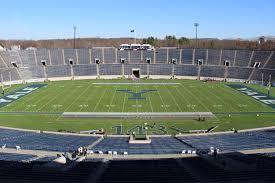
The following letter was sent to the President of Yale University, my alma mater:
Dear President Salovey,
In 2015 a journalist named Steve Almond wrote a well-reviewed book called “Against Football: One Fan’s Reluctant Manifesto,” which recounted the recent football player’s suit against the NFL for running a dangerous workplace. In an interview about the book in September of that year, he said:
For me, the most fascinating moment of everything that happened in the offseason was the announcement by the NFL itself in federal court. Their actuaries, in response to this massive lawsuit filed by all these former players saying, ‘you lied and covered up the damage done to our brains playing this game’, estimated that 30 percent of players were going to end up with long-term cognitive ailments, which is a polite way of saying brain damage. There is no business in America where, in the workplace, up to a third of the employees are going to get brain damage.
It probably has not escaped your notice that the evidence linking football-- with its high incidence of repetitive brain impacts at all levels of the sport—with both short-term impairments and long-term neurodegenerative disease, specifically chronic traumatic encephalopathy (CTE), has continued to mount.
Here are salient recent examples:
Without sustaining a single concussion, a North Carolina high school football team showed worrisome brain changes after a single season of play. A detailed effort to capture the on-field experiences of 24 high school football players showed that, at the end of one season, teammates whose heads sustained the most frequent contact with other moving bodies had the most pronounced changes in several measures of brain health. The study’s authors come from the University of Texas Southwestern Medical Center. A summary of the study can be found HERE.
A University of Toronto study evaluated a sixty-five subject group of athletes currently playing sports. One third were in non-contact sports, one third in contact sports and one third in “collision” sports. The players were evaluated at the start of their respective seasons, and again at the end, using MRI brain scans among other measures. The collision group had notably more negative results with regard to brain function indicators at the end of the season than either the non-contact or the collisions group. The full study is HERE.
Researchers analyzed the brains of a convenience sample of 202 deceased players of American football. CTE was neuropathologically diagnosed in 177 players across all levels of play (87%), including 110 of 111 former National Football League players (99%). This study was published in the Journal of the American Medical Association (JAMA) in July of 2017. The headline number is the 99%, but the more interesting number is the 87% one. This is the largest study of its kind to date.
The long-term neurological consequences of repetitive hits to the head has been researched for some time. The first scientific study of this phenomenon was published in JAMA in 1928. It related to boxers and was titled “Punch Drunk.” Anyone who saw Mohammed Ali in later life would not be surprised by the findings of this study.
For a more extensive and up to date summary of the academic research, see the testimony of Dr. Robert Stern, Director of Clinical Research at the Boston University Center for the Study of Chronic Traumatic Encephalopathy, presented on October 17, 2017 before the U.S. House Energy & Commerce Committee and the House Judiciary Committee.
You may have read recently of Aaron Hernandez, the condemned killer serving time for murdering a friend, who was before that a star tight end for the New England Patriots. He killed himself in prison at the age of 27. An autopsy of his brain, sponsored by his family, revealed a level of CTE that, according to the examining doctor, was "the most severe case they had ever seen in someone of Aaron's age."
The litigation mentioned at the beginning of this letter was initiated by a group of four thousand former players who sued the National Football League in 2012 for exposing them to this brain injury risk and not disclosing it. The final settlement, reached in 2015, is estimated to result in costs to the league of more than one billion dollars.
Perhaps more ominous is the recent concussion class action lawsuit brought against the NCAA by former college football and soccer players. The settlement agreement reached in 2016 requires the NCAA to pay $70 million for medical monitoring.
Based on all this and much more evidence of the football/CTE nexus, I respectfully suggest that you exercise leadership in the Ivy League and withdraw all university support for the participation of Yale students in intercollegiate and intramural tackle football.
There are strong ethical reasons for such a move. While the evidence may not yet be 100 percent conclusive—self-selection in some studies, small sample sizes, lack of a control group, etc., --one is reminded of the debate that swirled around the cigarette/lung cancer issue forty years ago. It is clear that there is real causal risk of long term brain damage linked to playing football at the collegiate level, and probably also at younger ages. It is laughable to imagine that further studies will prove that there is no such connection. And thus it is not ethical for the university to condone and even, yes, to glorify this sport for its students.
There is also a legitimate concern that by continuing to support football, the University puts itself at serious financial risk. It doesn’t take a genius to speculate on the next set of litigation related to football and CTE. Not just the NFL, but what better target than a well-endowed Ivy League school which sanctions and encourages the sport. It is not responsible to continue to incur this financial exposure whose magnitude is unknown and against whose consequences there is no way, to my knowledge, to be insured.
I strongly urge you to take this matter seriously and to discuss it with your administration colleagues, with senior faculty at the medical school, with the AYA, and of course with the Yale Corporation.
Shuttering the Yale Bowl is a big step, but the University no longer allows smoking on campus and has survived that dramatic change quite easily. It will no doubt survive without football, and its students will be better off, especially those who might have participated in this dangerous game.
Sincerely,
Robert F. Hemphill, Jr.
Yale College Class of 1966
Mr. Hemphill is the Chairman and CEO of Sunshine Soldiers, a non-profit focused on education activities happening in energy, especially with regard to the adoption of renewable energy technology by utilities, commercial customers and homeowners, and strategies to benefit from it. Hemphill is also the author for two business travel books, Stories From the Middle Seat: The Four-Million-Mile Journey to Building a Billion Dollar International Business and Dust Tea, Dingoes & Dragons: Adventure in Culture Cuisine & Commerce from a Globe-Trekking Executive.
